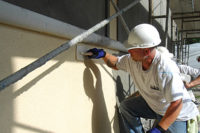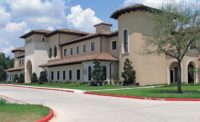Frequently the question is asked about stucco applications and what the difference is between one-coat, two-coat or three-coat stucco systems. The purpose of this article is to define the differences and not to choose one over the other as they all have their place. The success of either choice is based on the use of quality material and application procedures installed by trained professionals.
A good place to start is to define what is meant by the word “coat” as it relates to stucco. Stucco systems have multiple coats which refer to scratch coats, brown coats, and finish coats. A coat is defined as “a layer or thickness of stucco applied in a single operation.”
Step-by-Step Materials
Scratch Coat: First coat of plaster/stucco applied to the surface in two or three coat stucco work. The scratch coat is scarified horizontally to receive the next coat, the horizontal scratch coat aids in the mechanical adhesion of the brown coat.
Brown Coat:The second coat of a three coat application.
Finish Coat:The final coat of stucco (decorative surface), usually colored and textured either with a cement based finish or an acrylic finish.
Three-coat Conventional Stucco:The mix design and proportions of raw materials used in the mix are defined by ASTM C 926 Standard Specification for Application of Portland Cement-Based Plaster. Typical three-coat systems are installed over metal lath as a 3/8-inch scratch coat, 3/8-inch brown coat and 1/8-inch finish coat for a total thickness of 7/8-inch.
Two-coat Stucco (ASTM C 926): Typically over a solid plaster base of unit masonry or pre-cast or cast in place concrete with a 3/8-inch scratch, 1/8-inch brown and 1/8-inch finish coat for a total thickness of 5/8-inch (applied directly to the solid plaster base without lath).
Both three-coat and two-coat ASTM C 926 stucco applications are recognized in the building code and have a long track record of successful applications.
One-coat System:A non-traditional stucco systems which does not meet the above ASTM standard and is considered by the International Building Code as an alternative wall cladding. These systems are proprietary and were developed due to the energy crisis of the seventies where buildings in the Southwestern part of the United States were required to increase the R value of all exterior walls. These one-coat systems can incorporate tongue and groove insulation board over sheathing or open framing. All such alternate systems require a special evaluation service report based upon Acceptance Criteria for Cementitious Exterior Wall Coatings, published by the International Code Council.
Coating Compliance
There are some advantages to installing one-coat proprietary systems. Typical one-coat stucco materials that go through the process to comply to Acceptance Criteria for Cementitious Exterior Wall Coatingshave additional crack inhibiting fibers and proprietary ingredients that reduce or minimize shrinkage cracking. The one-coat stucco properties evaluated are structural, durability, fire resistance ratings and the types of construction (I through IV non-combustible construction) the material can be installed on.
One-coat stucco is quicker to apply using a reduced amount of material and labor. Another benefit is that one-coat stucco is a method of installation that should make stucco applications much easier to comply with the new ASHRAE 90.1 energy standard since the base coats are much lighter and thinner by virtue of the 3/8- to 1/2- nominal thicknesses, reducing the weight of the stucco assembly when applied over extruded or expanded polystyrene insulation to meet the requirements of ASHRAE 90.1.
When one-coat proprietary stucco is specified, make sure the material you are using has an Evaluation Service Report number. The ESR number will refer to a report that verifies that the material selected has been tested and complies with the Acceptance Criteria of AC 11. The material selected will also indicate that the material complies with AC 11 by having an ESR number posted on the packaging. The selected material will also have an ESR that can be used for reference of compliance. One-coat stuccoes without an ESR number have not been through the compliance of AC 11 and therefore the risk is that they would not be code compliant.
Pre-blended is Pre-measured
The above mentioned materials and their respective systems, whether the selection is for a traditional three-coat or one-coat stucco system are now available as pre-blended materials. The benefit of pre-blended stucco is that the proper proportions of the constituents of the mix; cement, lime, sand and fibers when specified are pre-measured at the factory. The applicator has only to add the proper amount of water. Pre-blended materials are also good for the environment as there is no need for a sand pile on the ground, which also eliminates ground contamination getting into the material (reducing the risk of efflorescence). Pre-blended stucco also makes the cleanup of the project at the end of the job easier because there are no sand pile remnants or discarded bags.
Both one-coat and three-coat materials can be either hand applied and pumped to the wall using specialized equipment.
The popularity of stucco continues to grow as it is a wall cladding system that is relatively low in maintenance, is visually pleasing and can be installed economically across the country.









Report Abusive Comment